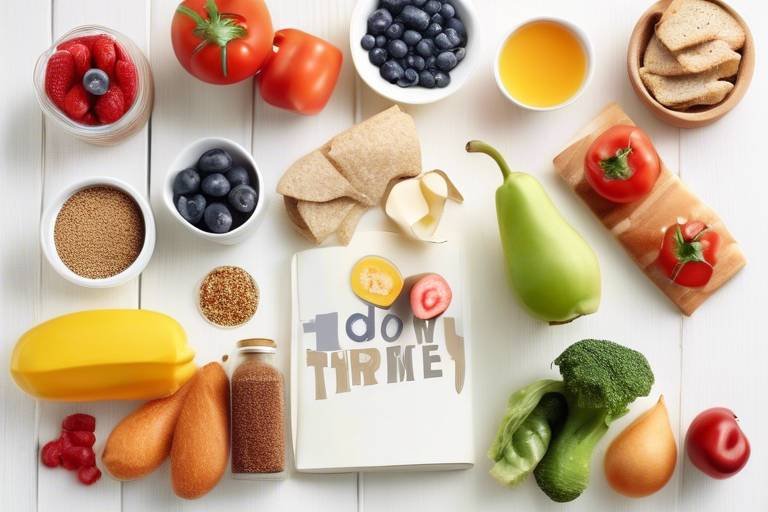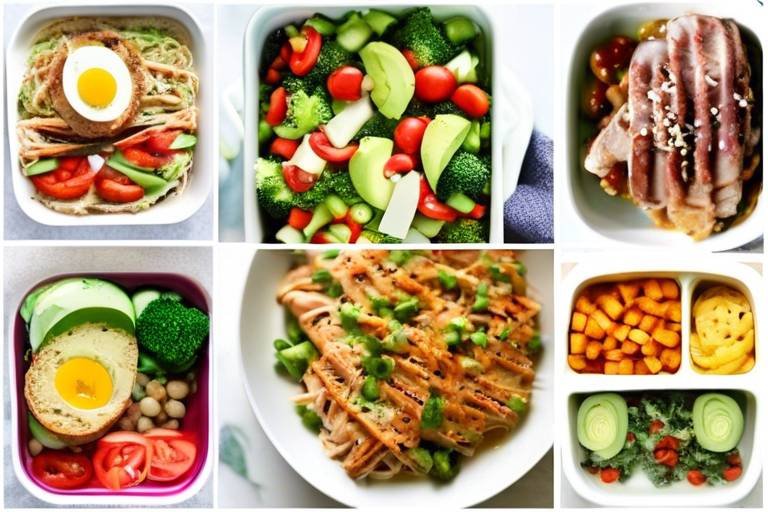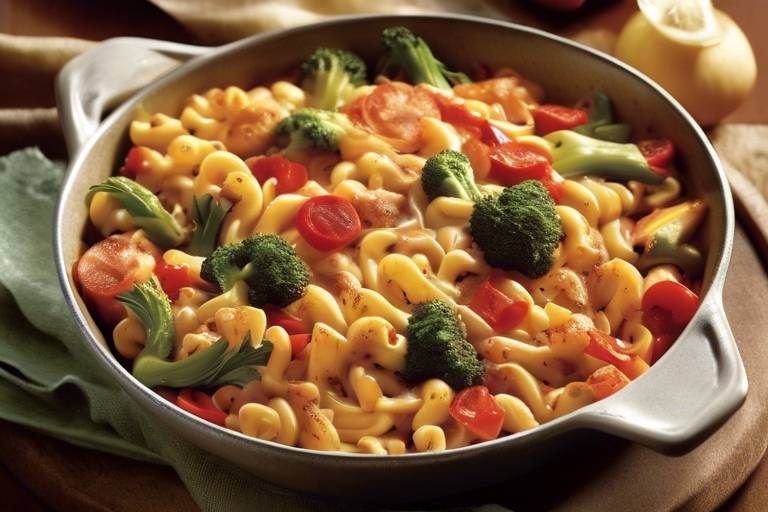Foods to Help Your Child Grow and Thrive
As parents, we often find ourselves navigating the vast world of nutrition, wondering what foods can truly help our children grow and thrive. It's a journey filled with questions, and the answers lie in understanding the essential nutrients that support our little ones' development. Think of nutrition as the fuel for a car; without the right kind, it simply won't run efficiently. In this article, we'll explore the foods that are not just tasty but are also packed with the nutrients necessary for healthy growth. By incorporating these foods into your child's diet, you're not just filling their bellies; you're laying down the building blocks for a strong, vibrant future.
Understanding the role of nutrition during childhood is crucial. Proper nutrition supports physical growth, cognitive development, and overall health, laying the foundation for a child's future well-being. Imagine a house being built: if the foundation is weak, the entire structure is at risk. Similarly, a child's early nutritional choices can influence their health for years to come. From boosting their immune system to enhancing their brain function, the right balance of nutrients is essential. So, what can we do to ensure our children are getting the best? Let’s dive into the key nutrients that play a pivotal role in their growth.
Certain nutrients are vital for children's growth. This section discusses essential vitamins and minerals, including calcium, iron, and vitamin D, which contribute to healthy development. Think of these nutrients as the superheroes of your child's diet. Each one has its own special powers that help combat various health issues. For instance, calcium is like a strong shield that protects bones, while iron is the energy booster that keeps them active and alert. Understanding these nutrients will empower you to make informed choices when planning meals.
Calcium is critical for bone health and density. As children grow, their bones are rapidly developing, and calcium acts as the building material for this growth. Without adequate calcium, children may face issues like stunted growth or weakened bones. So, how can we ensure they get enough? Here are some calcium-rich foods that can easily be included in your child's daily meals:
Dairy products are excellent sources of calcium. Milk, cheese, and yogurt not only provide calcium but also come with other essential nutrients like protein and vitamin D, which help in calcium absorption. For instance, a glass of milk can be a perfect addition to breakfast, or a serving of yogurt can make for a delicious and nutritious snack. The key is to make these options appealing. Try adding fruits or honey to yogurt for a flavor boost!
For lactose-intolerant children, non-dairy alternatives can provide necessary calcium. Plant-based options like almond milk, soy milk, and fortified tofu are excellent substitutes. Not only do they offer calcium, but they also come with their own unique flavors and benefits. For example, almond milk is low in calories and can be a refreshing drink on a hot day. Incorporating these alternatives can ensure that no child misses out on essential nutrients.
Iron is essential for energy levels and cognitive function. Without enough iron, children may feel tired and lethargic, which can affect their ability to learn and play. Foods rich in iron include lean meats, beans, and spinach. It's important to pair these foods with vitamin C sources, like oranges or bell peppers, to enhance iron absorption. Think of iron as the battery that powers your child's activities; without it, they may run out of energy quickly!
Fruits and vegetables are packed with vitamins and antioxidants. These colorful foods play a crucial role in boosting immunity and overall health in children. They are not just side dishes; they are the main players in a healthy diet. By incorporating a variety of fruits and vegetables, you can provide your child with a spectrum of nutrients that are essential for their growth.
Encouraging children to eat a variety of colorful fruits and vegetables can enhance their nutrient intake. The more colors on their plate, the more nutrients they are likely consuming. Try to make meals fun by creating colorful salads or smoothies. You might even turn it into a game: challenge your child to eat a rainbow of fruits and vegetables each day!
Incorporating seasonal fruits and vegetables can maximize freshness and flavor. Seasonal produce not only tastes better but is often more affordable. Visit local farmers' markets or grocery stores to find what's in season. When you bring home fresh produce, involve your child in the preparation. Whether it's washing, peeling, or mixing, making them part of the process can encourage them to try new things.
- What are the best sources of calcium for children? Dairy products like milk, cheese, and yogurt are excellent sources, as well as fortified non-dairy alternatives.
- How can I get my child to eat more vegetables? Involve them in meal prep and make it fun! Try colorful presentations and dips to make veggies more appealing.
- What are some iron-rich foods for kids? Lean meats, beans, lentils, and spinach are great sources of iron.

Importance of Nutrition in Childhood
Understanding the role of nutrition during childhood is crucial for every parent and caregiver. Think of it as the foundation of a house; if the foundation is weak, everything built on top of it can crumble. Proper nutrition supports not just physical growth but also cognitive development and overall health. It lays the groundwork for a child's future well-being, affecting everything from their ability to learn in school to their overall happiness.
When children consume a balanced diet rich in essential nutrients, they are more likely to achieve their growth milestones and develop strong immune systems. This means fewer sick days and more time spent playing, learning, and exploring the world around them. In fact, studies show that children who eat well are often more energetic and better able to concentrate, making them more successful in their academic pursuits.
Moreover, the importance of nutrition extends beyond just physical health. It plays a significant role in emotional and mental well-being. A diet lacking in vital nutrients can lead to mood swings, irritability, and even long-term mental health issues. Thus, ensuring that your child receives a variety of foods rich in vitamins, minerals, and other nutrients can help them feel their best, both physically and emotionally.
So, what does a well-rounded diet look like for children? It’s not just about avoiding junk food; it’s about embracing a colorful array of whole foods that provide the nutrients they need. Here are a few key components:
- Fruits and Vegetables: These are packed with vitamins, minerals, and antioxidants that support immune function.
- Whole Grains: Foods like brown rice and whole wheat bread provide essential fiber and energy.
- Proteins: Lean meats, fish, beans, and nuts are crucial for growth and repair of tissues.
- Dairy: Provides calcium and vitamin D, essential for strong bones and teeth.
In summary, the right nutrition during childhood is not just a matter of physical health; it’s a holistic approach that supports emotional and cognitive development as well. By prioritizing a nutritious diet, you’re investing in your child’s future, helping them to grow into healthy, happy adults. So, let’s dive deeper into the specific nutrients that are essential for your child’s growth and how you can easily incorporate them into their daily meals!

Key Nutrients for Growth
When it comes to ensuring that your child grows up healthy and strong, nutrition plays a pivotal role. Just like a sturdy building needs a solid foundation, children require essential nutrients to support their growth and development. These nutrients are not just beneficial; they are critical for laying the groundwork for a healthy future. So, what are these key nutrients that every parent should be aware of? Let’s dive into some of the most important ones—calcium, iron, and vitamin D—each of which contributes uniquely to your child's well-being.
Calcium is often hailed as the superhero of bone health. It’s crucial for developing strong bones and teeth, especially during the growing years. Without adequate calcium, children risk developing weak bones, which can lead to issues like osteoporosis later in life. So, how can you ensure your child is getting enough calcium? Here are some calcium-rich foods that can easily be incorporated into their diet:
- Dairy Products: Milk, cheese, and yogurt are some of the best sources of calcium. A glass of milk with breakfast or a yogurt snack can go a long way.
- Leafy Greens: Vegetables like kale and broccoli are not only nutritious but also provide a good amount of calcium.
- Fortified Foods: Many cereals and plant-based milks are fortified with calcium, making them excellent choices for breakfast or snacks.
Next up is iron, which is essential for energy levels and cognitive development. Iron plays a vital role in producing hemoglobin, the protein in red blood cells that carries oxygen throughout the body. Without enough iron, children may experience fatigue and decreased immune function. To keep your little ones energized and alert, consider incorporating iron-rich foods into their meals:
- Red Meat: Beef and lamb are excellent sources of heme iron, which is more easily absorbed by the body.
- Poultry and Fish: Chicken, turkey, and fish also provide significant amounts of iron.
- Legumes: Beans, lentils, and chickpeas are fantastic plant-based sources of iron, perfect for vegetarian diets.
Finally, let’s not forget about vitamin D. This nutrient is crucial for calcium absorption and bone health. Vitamin D also plays a role in immune function and has been linked to mood regulation. The sun is a natural source of vitamin D, but it can be hard to get enough, especially in winter months. Here are some foods that can help boost your child's vitamin D levels:
- Fatty Fish: Salmon and mackerel are not only delicious but also packed with vitamin D.
- Egg Yolks: Including eggs in your child’s breakfast can be a tasty way to add vitamin D to their diet.
- Fortified Foods: Many dairy products and cereals are fortified with vitamin D, making them an easy addition to meals.
In summary, ensuring your child gets a balanced intake of these critical nutrients—calcium, iron, and vitamin D—will set the stage for healthy growth and development. By incorporating a variety of foods rich in these nutrients into their diet, you can help your child thrive. Remember, a well-nourished child is a happy child, and ultimately, that’s what every parent wants!
Q: How can I tell if my child is getting enough calcium?
A: Look for signs such as growth delays or frequent fractures. You can also consult your pediatrician for a dietary assessment.
Q: What are some signs of iron deficiency in children?
A: Symptoms may include fatigue, pale skin, and irritability. If you suspect a deficiency, a blood test can confirm it.
Q: How can I make fruits and vegetables more appealing to my child?
A: Try creative presentations, such as fruit skewers or colorful salads, and involve your child in the cooking process to spark their interest.

Calcium for Strong Bones
When it comes to our children's growth, calcium plays a starring role, much like the backbone of a well-structured building. It’s essential for developing strong bones and teeth, providing the support your child needs to grow tall and strong. Think of calcium as the foundation that helps your child's body develop properly, ensuring they have the strength to run, jump, and play without fear of injury. But how do we ensure they're getting enough of this crucial mineral?
First off, it’s important to know what foods are rich in calcium. Dairy products are the classic go-to source, but there’s a whole world of options out there! Here’s a quick look at some of the best sources:
| Food Item | Calcium Content (mg per serving) |
|---|---|
| Milk (1 cup) | 300 |
| Yogurt (1 cup) | 400 |
| Cheddar Cheese (1.5 oz) | 300 |
| Almonds (1 oz) | 76 |
| Tofu (1/2 cup) | 253 |
Incorporating these foods into your child's diet can be as easy as pie! For instance, a glass of milk with breakfast or a yogurt parfait as a snack can do wonders. But what if your child is lactose intolerant or simply prefers non-dairy options? Not to worry! There are plenty of non-dairy alternatives that can still pack a calcium punch. Almond milk, fortified orange juice, and leafy greens like kale and bok choy are fantastic options that can easily be included in their meals.
Another fun way to ensure your kids are getting enough calcium is by making it a family affair. Get them involved in the kitchen! Let them help prepare a cheesy pasta dish or a smoothie with spinach and almond milk. When children take part in the cooking process, they are often more inclined to try new foods. Plus, it’s a great opportunity to teach them about the importance of nutrition and how it affects their health.
So, next time you're at the grocery store, remember that calcium is not just a mineral; it’s a vital part of your child's growth journey. With a little creativity and some delicious options, you can help your child build strong bones and a healthy future!
- How much calcium does my child need? The recommended daily intake varies by age, but generally, children aged 1-3 need about 700 mg, while those aged 4-8 require 1,000 mg.
- Can my child get enough calcium from a vegan diet? Yes! With careful planning, a vegan diet can provide adequate calcium through fortified plant-based milks, tofu, and leafy greens.
- What are the signs of calcium deficiency? Symptoms can include brittle bones, dental issues, and muscle cramps. If you suspect a deficiency, consult your pediatrician.

Dairy Products
Dairy products are not just delicious; they are also powerhouses of nutrition, particularly when it comes to supporting your child's growth. Packed with calcium, protein, and essential vitamins, these foods play a crucial role in developing strong bones and healthy teeth. Imagine your child's body as a building under construction; without the right materials, that structure won't stand tall or strong. Dairy provides the bricks and mortar needed for robust growth!
When we think of dairy, the first things that come to mind are milk, cheese, and yogurt. Each of these options offers unique benefits:
- Milk: Whether it's whole, skim, or fortified, milk is a fantastic source of calcium and vitamin D, which work hand-in-hand to strengthen bones.
- Cheese: Not only is cheese a tasty snack, but it also contains concentrated amounts of calcium. Plus, it can be a fun ingredient in various dishes!
- Yogurt: This creamy delight is packed with probiotics, which are great for gut health. Opt for plain yogurt and add fresh fruits for a nutritious twist.
Incorporating dairy into your child's diet can be as simple as adding a glass of milk to breakfast or serving yogurt with lunch. However, it's essential to keep in mind that some children may be lactose intolerant or prefer non-dairy options. In such cases, there are plenty of alternatives available that can still provide those vital nutrients.
To visualize the benefits of dairy, consider the following table that outlines the calcium content in various dairy products:
| Dairy Product | Calcium Content (mg per serving) |
|---|---|
| 1 cup of Milk | 300 |
| 1 oz of Cheese | 200 |
| 1 cup of Yogurt | 400 |
Ultimately, dairy products can be a fun and tasty way to ensure your child gets the calcium they need for optimal growth. By creatively incorporating these foods into your meals, you can help establish healthy eating habits that will last a lifetime. So, why not whip up a smoothie with yogurt and fruits or make a cheesy pasta dish that your kids will love? The possibilities are endless!
Q: What if my child is lactose intolerant?
A: There are many lactose-free dairy products available, such as lactose-free milk and yogurt. Additionally, fortified plant-based alternatives like almond milk or soy yogurt can provide similar nutrients.
Q: How much dairy should my child consume daily?
A: The recommended daily intake varies by age, but generally, children aged 2-3 years should have about 2 cups of dairy, while children aged 4-8 years should aim for 2.5 cups.
Q: Can dairy help with my child's overall health?
A: Absolutely! Dairy products are not only rich in calcium but also provide protein, vitamins A and D, and are often fortified with other essential nutrients that contribute to overall health.

Non-Dairy Alternatives
For children who are lactose intolerant or have a dairy allergy, can be a fantastic way to ensure they still receive essential calcium and other nutrients necessary for their growth. Thankfully, the market is brimming with delicious and nutritious options that can easily be incorporated into your child’s diet. These alternatives not only provide calcium but also come fortified with vitamins and minerals that are crucial for overall health.
One of the most popular non-dairy alternatives is almond milk. It’s not only creamy and delicious but also low in calories compared to regular milk, making it a great choice for children who may be watching their weight. Additionally, almond milk is often fortified with calcium and vitamin D, providing the same benefits as traditional dairy products. You can use almond milk in smoothies, cereals, or even in baking to maintain that creamy texture without the lactose.
Another excellent option is soy milk. Soy milk is unique in that it contains a similar amount of protein as cow's milk, making it a great substitute for growing children. It’s rich in essential amino acids and is often fortified with calcium and vitamins A and D. This makes soy milk not just a replacement but a superfood in its own right. You can serve it chilled, use it in cooking, or blend it into your child’s favorite smoothies for an extra protein boost.
Coconut milk is also gaining popularity among parents. Its rich and creamy texture can be quite appealing to children, and while it has less protein than almond or soy milk, it still provides a unique flavor that can enhance various dishes. Coconut milk is often used in curries, soups, or even desserts, making it a versatile addition to your kitchen. Just be mindful of its higher fat content, and balance it with other nutrient-dense foods.
For those who prefer a more traditional approach, tofu is an excellent non-dairy source of calcium. It’s incredibly versatile and can be used in both savory and sweet dishes. You can blend it into smoothies, scramble it like eggs, or even use it in baking as a substitute for dairy. Tofu is not only packed with protein but also provides essential minerals, making it a powerhouse food for children.
Here’s a quick comparison of some popular non-dairy alternatives:
| Non-Dairy Alternative | Calcium Content (per cup) | Protein Content (per cup) |
|---|---|---|
| Almond Milk | 450 mg | 1 g |
| Soy Milk | 300 mg | 7 g |
| Coconut Milk | 45 mg | 0 g |
| Tofu (firm) | 250 mg | 20 g |
Incorporating these non-dairy alternatives into your child's diet can be as simple as swapping out regular milk for almond or soy milk in their morning cereal or using tofu in stir-fries. The key is to experiment and find what your child enjoys the most. Remember to check labels for fortification, as many brands offer enhanced nutritional profiles. With these alternatives, you can ensure your child is not missing out on essential nutrients while enjoying a diverse and delicious diet.

Iron for Energy and Development
When it comes to your child's growth and development, iron plays a starring role. This essential mineral is like the fuel that keeps the engine running smoothly. Without enough iron, children can feel fatigued, which can hinder their ability to focus and learn. Imagine trying to run a race but feeling like you're dragging a heavy backpack; that's what a lack of iron can feel like for your child. It’s crucial for producing hemoglobin, the protein in red blood cells that carries oxygen throughout the body. So, how can you ensure your child gets enough of this vital nutrient?
First, let’s talk about the amazing sources of iron. There are two types of dietary iron: heme iron and non-heme iron. Heme iron, found in animal products, is more easily absorbed by the body. On the other hand, non-heme iron, which comes from plant sources, requires a little help for better absorption. Pairing non-heme iron foods with vitamin C-rich foods can enhance absorption significantly. For instance, serving a spinach salad with orange slices can turn a simple meal into a powerhouse of nutrients!
Here’s a quick breakdown of some iron-rich foods you might want to consider:
| Food Source | Type of Iron | Iron Content (mg per serving) |
|---|---|---|
| Red Meat | Heme | 2.1 - 3.5 |
| Poultry | Heme | 1.0 - 2.0 |
| Beans and Lentils | Non-Heme | 3.2 - 6.6 |
| Spinach | Non-Heme | 0.8 - 6.4 |
| Fortified Cereals | Non-Heme | 3.6 - 18.0 |
It's also important to watch for signs of iron deficiency, which can manifest as fatigue, pale skin, or irritability. If you notice any of these symptoms, it might be worth consulting a healthcare professional for advice. Remember, while iron is crucial for energy and development, balance is key. Too much iron can also lead to health issues, so always aim for a well-rounded diet.
Incorporating iron-rich foods into your child's meals doesn't have to be a chore. Get creative! You could whip up a delicious chili loaded with beans, or perhaps a stir-fry featuring chicken and colorful veggies. Making meals fun and engaging can encourage your child to try new foods that are beneficial for their health.
In conclusion, ensuring your child has enough iron in their diet is essential for their energy levels and overall development. By introducing a variety of iron-rich foods and pairing them with vitamin C sources, you can help set your child up for success in their growth journey.
- What are the symptoms of iron deficiency in children? Symptoms can include fatigue, pale skin, irritability, and difficulty concentrating.
- How can I increase my child's iron intake? Include iron-rich foods like red meat, poultry, beans, and fortified cereals in their diet, and pair non-heme iron sources with vitamin C-rich foods.
- Is iron supplementation necessary? It depends on the child's diet and health. Consult a healthcare professional before starting any supplements.

Fruits and Vegetables for Vital Vitamins
When it comes to nurturing our little ones, fruits and vegetables are the unsung heroes of their diet. These vibrant, colorful foods are not just eye-catching; they are packed with essential vitamins and antioxidants that play a crucial role in boosting immunity and supporting overall health. Imagine your child's body as a high-performance car; without the right fuel—like the vitamins found in fruits and vegetables—it simply won't run at its best. So, let’s dive into why these foods are so important and how you can make them a delightful part of your child's meals.
First off, let's talk about the incredible range of vitamins found in fruits and vegetables. For instance, vitamin C is a powerhouse for the immune system, helping to ward off colds and infections. You can find this vitamin in citrus fruits like oranges and grapefruits, as well as in bell peppers and broccoli. Then there's vitamin A, which is essential for vision and skin health, present in foods like carrots and sweet potatoes. These nutrients are not just beneficial; they are vital for your child's growth and development.
But how do we get our picky eaters to enjoy these healthy options? One effective strategy is to make their plates as colorful as a painter's palette. When children see a variety of colors, they are often more intrigued and willing to try new things. You might say, “Hey, look at this rainbow on your plate!” This simple trick can turn mealtime into an exciting adventure, encouraging them to taste everything from deep purple eggplants to bright red strawberries.
Another tip is to incorporate seasonal produce into your meals. Not only does seasonal produce taste better, but it also tends to be more affordable and nutritious. For example, during the summer, you can enjoy juicy peaches and watermelons, while fall brings the deliciousness of pumpkins and apples. You can even involve your child in the selection process by taking them to a farmers' market. Allow them to pick out their favorite fruits and vegetables; this simple act can make them feel more invested in their meals.
To give you a clearer picture of how to incorporate various fruits and vegetables into your child's diet, here’s a simple table showcasing some nutrient-rich options:
| Fruit/Vegetable | Key Vitamins | Fun Fact |
|---|---|---|
| Carrots | Vitamin A | They can help you see better in the dark! |
| Broccoli | Vitamin C, K | Broccoli is actually a flower! |
| Strawberries | Vitamin C | They are the only fruit with seeds on the outside! |
| Spinach | Vitamin K, A | Popeye's favorite for a reason! |
In summary, incorporating a variety of fruits and vegetables into your child's diet is not just about meeting nutritional needs; it's about creating a foundation for a healthy lifestyle. By making these foods fun and engaging, you're not only helping them grow physically but also instilling lifelong healthy eating habits. So, let’s embrace the colorful world of fruits and veggies and watch our kids thrive!
Q: How can I encourage my child to eat more fruits and vegetables?
A: Try making meals colorful, involve them in grocery shopping, and offer a variety of options. Sometimes, presenting food in fun shapes or with dips can make it more appealing!
Q: Are frozen fruits and vegetables as nutritious as fresh ones?
A: Yes! Frozen fruits and vegetables can be just as nutritious as fresh ones, especially if they are frozen shortly after harvest. They can be a convenient option to have on hand.
Q: What are some easy ways to include fruits and vegetables in snacks?
A: You can create fruit smoothies, serve sliced veggies with hummus, or make fruit salads. Get creative with dips and toppings to make them more exciting!

Colorful Choices
When it comes to encouraging children to eat healthy, one of the most effective strategies is to make their meals as colorful as possible. Imagine a vibrant plate filled with an array of colors—red, orange, green, yellow, and purple. Each color represents different nutrients, and the more colors you can include, the more varied the nutrients your child will consume. But why is this important? Well, just like a rainbow, a diverse selection of fruits and vegetables can create a visual feast that can entice even the pickiest of eaters.
To make these colorful choices appealing, consider involving your child in the selection process. Take them to the grocery store or a local farmer's market and let them pick out their favorite fruits and vegetables. This not only gives them a sense of ownership but also makes them more likely to eat what they’ve chosen. For example, if they pick out bright red strawberries or crunchy green bell peppers, they might be more excited to include them in their meals. Plus, the experience can be educational, teaching them about where food comes from and the importance of eating a variety of foods.
Another fun way to encourage colorful eating is to create themed meals. For instance, you could have a “rainbow salad” night where you challenge your child to include as many colors as possible. You could use ingredients like:
- Red: Cherry tomatoes, red bell peppers
- Orange: Carrots, orange bell peppers
- Yellow: Corn, yellow squash
- Green: Spinach, cucumbers
- Blue/Purple: Blueberries, purple cabbage
Not only does this make meals visually appealing, but it also teaches your child to appreciate the variety of flavors and textures that come with different fruits and vegetables. Additionally, you can get creative by making smoothies that combine multiple colorful ingredients. A smoothie made with spinach, bananas, strawberries, and blueberries not only looks beautiful but packs a nutritional punch that can help fuel your child's day.
Incorporating colorful fruits and vegetables into your child's diet can also boost their immune system. Each color represents different vitamins and antioxidants that work together to keep your child healthy. For example, orange and yellow fruits like oranges and mangoes are high in vitamin C, which is essential for fighting off colds and infections. Meanwhile, green vegetables like broccoli and spinach are rich in iron and calcium, vital for growth and development.
In conclusion, making colorful choices when it comes to fruits and vegetables is not just about aesthetics; it’s about creating a healthy, balanced diet that can help your child grow and thrive. So the next time you’re planning meals, remember to think in color! Your child’s plate can be a canvas of health, and you are the artist who can inspire them to make nutritious choices.
Q: How can I get my child to try new fruits and vegetables?
A: Start by introducing small amounts of new foods alongside their favorites. Make it fun by involving them in cooking or choosing their meals at the grocery store.
Q: Are frozen fruits and vegetables as nutritious as fresh ones?
A: Yes! Frozen fruits and vegetables can be just as nutritious as fresh ones, especially if they are frozen shortly after being harvested.
Q: What are some easy ways to incorporate more vegetables into meals?
A: Try adding finely chopped vegetables into sauces, soups, or even smoothies. You can also serve veggies as snacks with dips like hummus or yogurt.

Seasonal Produce
When it comes to feeding your little ones, can be a game changer! Not only does it offer the freshest flavors, but it also packs a nutritional punch that can help your child grow and thrive. Imagine biting into a juicy, sun-ripened strawberry or crunching on a crisp, vibrant carrot straight from the garden. These seasonal delights are not just tasty; they are also bursting with vitamins and minerals that are essential for your child's development.
Incorporating seasonal fruits and vegetables into your child's diet is like giving them a superfood boost. These foods are often picked at their peak ripeness, which means they contain the highest levels of nutrients. Plus, they are generally more affordable when they are in season, making it easier on your wallet. So, why not take advantage of nature's bounty? Here are a few tips to help you make the most of seasonal produce:
- Visit Local Farmers' Markets: These markets are a treasure trove of fresh, seasonal fruits and vegetables. You can often find unique varieties that you won't see in grocery stores.
- Get Your Kids Involved: Take your children with you to pick out fruits and veggies. This not only teaches them about healthy eating but also gives them a sense of ownership over their food choices.
- Plan Your Meals: Create a weekly meal plan that incorporates seasonal produce. This will help you stay organized and ensure that your family is getting a variety of nutrients.
Another fantastic aspect of seasonal produce is the opportunity to introduce your child to new flavors and textures. For instance, in the spring, you might find tender asparagus and sweet peas, while summer brings a bounty of berries and tomatoes. Autumn is perfect for hearty squashes and vibrant root vegetables, and winter offers citrus fruits that are both refreshing and packed with vitamin C. By rotating these seasonal options, you can keep mealtime exciting and ensure that your child is getting a well-rounded diet.
Moreover, seasonal produce is often more environmentally friendly. When you buy local, you reduce the carbon footprint associated with transporting food long distances. This is not just great for your family but also for the planet! It's a win-win situation that teaches your children the importance of sustainability while nourishing their bodies.
To wrap it up, embracing seasonal produce is one of the easiest ways to enhance your child's diet. Not only does it provide essential nutrients, but it also introduces them to a world of flavors and textures that they might not experience otherwise. So, the next time you're at the grocery store or farmer's market, think about what’s in season and get creative with your meals!
Q: How can I tell what fruits and vegetables are in season?
A: You can check local agricultural websites or farmers' market schedules to find out which produce is currently in season in your area. Seasonal produce often varies by region, so it's good to be informed!
Q: Are there any benefits to eating organic seasonal produce?
A: Yes! Organic seasonal produce is often grown without synthetic pesticides and fertilizers, making it a healthier option for your child. Plus, it supports local farmers and promotes biodiversity.
Q: How can I encourage my child to eat more fruits and vegetables?
A: Get creative! Involve your child in meal prep, make colorful salads, or try fun recipes that incorporate seasonal produce. The more involved they are, the more likely they are to try new things!
Frequently Asked Questions
- What are the best foods to promote my child's growth?
To help your child grow and thrive, focus on foods rich in essential nutrients. Incorporate dairy products like milk, cheese, and yogurt for calcium, lean meats and beans for iron, and a variety of fruits and vegetables for vitamins and antioxidants.
- How important is calcium for my child's development?
Calcium is crucial for developing strong bones and teeth. It plays a significant role in preventing bone-related issues later in life. Ensure your child gets enough calcium through dairy or fortified non-dairy alternatives like almond milk and tofu.
- What should I do if my child is lactose intolerant?
If your child is lactose intolerant, don't worry! There are plenty of non-dairy alternatives available, such as almond milk, soy milk, and fortified orange juice. These can provide the necessary calcium without the discomfort.
- How can I encourage my child to eat more fruits and vegetables?
Make fruits and vegetables fun! Get creative by involving your child in the kitchen—let them help prepare colorful salads or smoothies. You can also try making meals visually appealing by arranging food in fun shapes or using dips.
- Are there specific fruits and vegetables that are better for my child's health?
Yes! Aim for a rainbow of colors on their plate. Dark leafy greens, carrots, berries, and citrus fruits are all packed with vitamins and antioxidants that support immunity and overall health.
- How can seasonal produce benefit my child's diet?
Seasonal produce is often fresher and more flavorful, making it more appealing to kids. Plus, it can be more nutritious as it’s picked at peak ripeness. Visit local farmers' markets to find what's in season and introduce your child to new fruits and vegetables!
- What role does iron play in my child's growth?
Iron is vital for energy and cognitive function. It helps prevent anemia, which can lead to fatigue and poor concentration. Include iron-rich foods like red meat, spinach, and fortified cereals in your child's diet to support their growth.


















